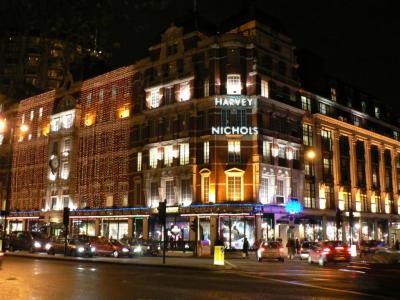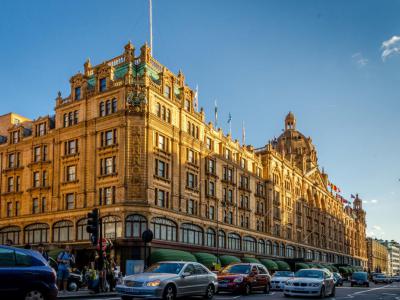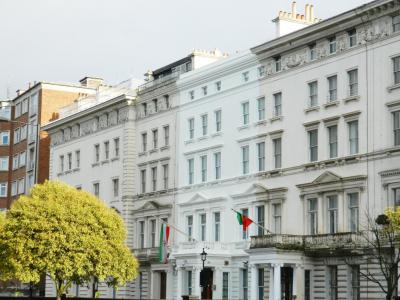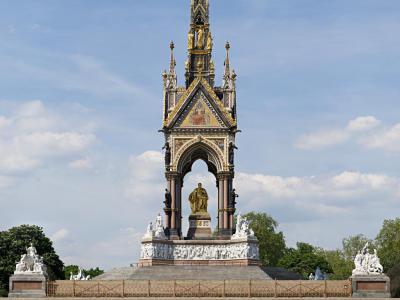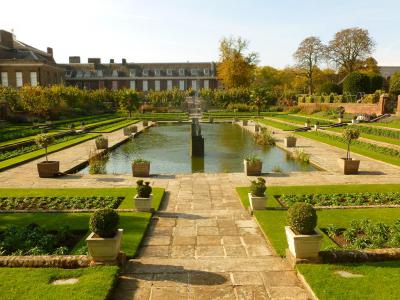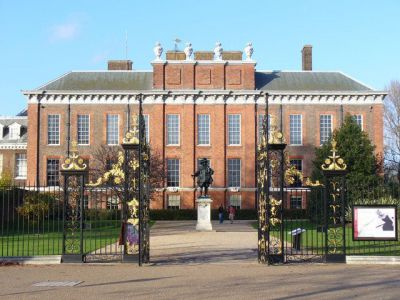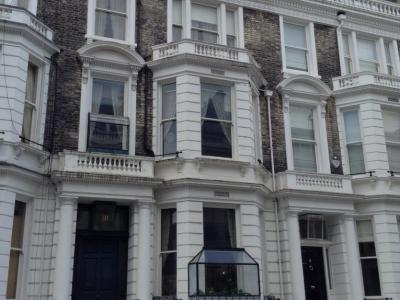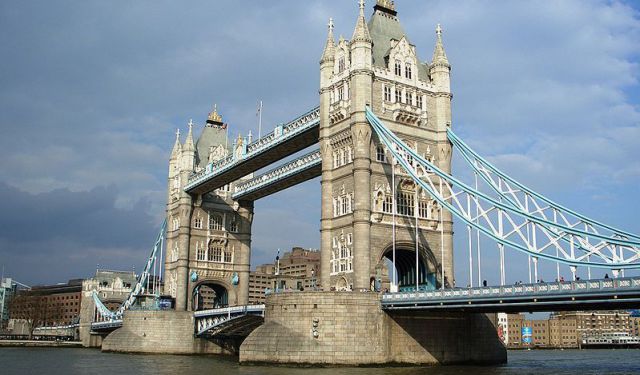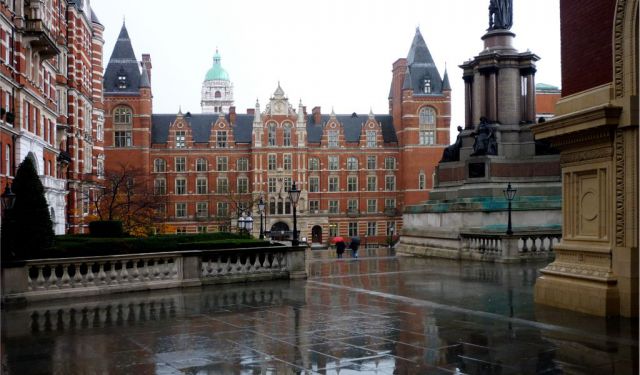
Kensington/Knightsbridge Walking Tour (Self Guided), London
Situated just below Hyde Park, Knightsbridge and South Kensington are two adjacent neighborhoods with grand Victorian homes and leafy garden squares. Home to London’s most expensive homes, Knightsbridge has some of the highest density of millionaires in the world. This is clearly reflected in the selection of stores & restaurants in the area, including the famous Harvey Nichols and Harrods department stores.
Next comes a very Mediterranean corner of London: Ennismore Gardens Mews – a cobbled, L-shaped idyllic hamlet tucked away from the bustle of Knightsbridge and even boasting its own arch!
If you get the chance, go to a concert or activity in the iconic Royal Albert Hall. If not, then be sure to admire both its initial simplicity of design and its beautiful detail. Located nearby is the huge Albert Memorial, an interesting attraction in its own right.
On this self-guided walking tour, you will also visit Kensington Gardens and former Princess Diana's residence, with various tours offered and exhibitions on display, among which some lovely items in Diana’s memory. You’ll also be able to catch more than a glimpse of Queen Victoria’s life before she became the 2nd-longest British reigning monarch.
If that’s wasn’t enough, finish with the Leighton House Museum – a jewel of an artist house that has been preserved as a love letter to Lord Leighton and his contemporaries. Its chief glory is the Arab Hall, packed with wonderful tiles, mosaics, and stained glass.
Follow the map and explore at your own pace!
Next comes a very Mediterranean corner of London: Ennismore Gardens Mews – a cobbled, L-shaped idyllic hamlet tucked away from the bustle of Knightsbridge and even boasting its own arch!
If you get the chance, go to a concert or activity in the iconic Royal Albert Hall. If not, then be sure to admire both its initial simplicity of design and its beautiful detail. Located nearby is the huge Albert Memorial, an interesting attraction in its own right.
On this self-guided walking tour, you will also visit Kensington Gardens and former Princess Diana's residence, with various tours offered and exhibitions on display, among which some lovely items in Diana’s memory. You’ll also be able to catch more than a glimpse of Queen Victoria’s life before she became the 2nd-longest British reigning monarch.
If that’s wasn’t enough, finish with the Leighton House Museum – a jewel of an artist house that has been preserved as a love letter to Lord Leighton and his contemporaries. Its chief glory is the Arab Hall, packed with wonderful tiles, mosaics, and stained glass.
Follow the map and explore at your own pace!
How it works: Download the app "GPSmyCity: Walks in 1K+ Cities" from Apple App Store or Google Play Store to your mobile phone or tablet. The app turns your mobile device into a personal tour guide and its built-in GPS navigation functions guide you from one tour stop to next. The app works offline, so no data plan is needed when traveling abroad.
Kensington/Knightsbridge Walking Tour Map
Guide Name: Kensington/Knightsbridge Walking Tour
Guide Location: England » London (See other walking tours in London)
Guide Type: Self-guided Walking Tour (Sightseeing)
# of Attractions: 11
Tour Duration: 2 Hour(s)
Travel Distance: 4.5 Km or 2.8 Miles
Author: Xena
Sight(s) Featured in This Guide:
Guide Location: England » London (See other walking tours in London)
Guide Type: Self-guided Walking Tour (Sightseeing)
# of Attractions: 11
Tour Duration: 2 Hour(s)
Travel Distance: 4.5 Km or 2.8 Miles
Author: Xena
Sight(s) Featured in This Guide:
- Harvey Nichols
- Harrods
- Ennismore Gardens Mews
- 14 Prince's Gate
- Royal Albert Hall
- Albert Memorial
- Kensington Gardens
- Kensington Palace
- Kensington High Street
- Sambourne House
- Leighton House Museum
1) Harvey Nichols
While Harrods remains a popular destination for visiting tourists, local fashion enthusiasts prefer Harvey Nichols, affectionately known as "Harvey Nicks", a store that was once a favorite of Princess Diana and later frequented by Duchess Kate. The women's clothing and accessory sections are truly exceptional, showcasing renowned designers like Tom Ford, Loewe, Roland Mouret, Valentino, Tory Burch, and an array of other esteemed fashion labels. The furniture and home decor offerings are equally exquisite, albeit on the pricier side, although they do become more affordable during the biannual sales in January and July.
The 5th floor of Harvey Nichols is a veritable haven for food enthusiasts, housing a gourmet grocery store, an upscale bar (the ideal spot for socializing and being seen), an outdoor terrace, and a vibrant café. To ensure you look as fresh as your newly acquired purchases, the Beauty Lounge offers a menu of treatments featuring renowned brands like La Prairie, Sisley, and La Mer. These treatments encompass makeovers, LED facials, cryotherapy, thermotherapy, laser procedures, as well as hair, nail, and eyebrow styling stations.
The 5th floor of Harvey Nichols is a veritable haven for food enthusiasts, housing a gourmet grocery store, an upscale bar (the ideal spot for socializing and being seen), an outdoor terrace, and a vibrant café. To ensure you look as fresh as your newly acquired purchases, the Beauty Lounge offers a menu of treatments featuring renowned brands like La Prairie, Sisley, and La Mer. These treatments encompass makeovers, LED facials, cryotherapy, thermotherapy, laser procedures, as well as hair, nail, and eyebrow styling stations.
2) Harrods (must see)
Today, Harrods is primarily frequented by window-shopping tourists and affluent international visitors, with fewer of the budget-conscious locals in sight. It's best regarded as the world's largest, most upscale, and most extravagant shopping destination, akin to a colossal mall. Spanning over four acres of retail space across seven floors, it boasts a comprehensive collection of luxury brands that could easily occupy a shopper's entire day. Grand in scale yet retaining an air of sophistication, Harrods offers a vast range of products, including clothing, electronics, jewelry, sporting gear, pet accessories, toys, food and drink, health and beauty items, packaged gifts, stationery, housewares, home appliances, furniture, and much more.
On the ground floor, you'll discover the Food Halls, featuring Edwardian tiled walls, imaginative and extravagant displays, and staff adorned in period attire—a far cry from your typical neighborhood supermarket.
Take a ride on the Egyptian Escalator, adorned with pharaoh-themed sconces, papyrus-shaped lamps, and balconies adorned with hieroglyphics, up to the 3rd floor. Here, you'll find an extraordinary toy department, complete with an impressive Harry Potter section and extravagant items like child-sized luxury pedal cars—an ideal gift for the child who seemingly has everything.
Harrods doesn't skimp on dining options either, boasting more than two dozen eateries scattered throughout the store. Choices range from a sushi bar, deli, and pizzeria to a Ladurée macaron parlor and a burger bar.
While some individuals may deem Harrods as overpriced and elitist, it remains a unique department store, distinguished by its very own gift shop and even a Dale Chihuly chandelier, situated near the exit of door 3.
On the ground floor, you'll discover the Food Halls, featuring Edwardian tiled walls, imaginative and extravagant displays, and staff adorned in period attire—a far cry from your typical neighborhood supermarket.
Take a ride on the Egyptian Escalator, adorned with pharaoh-themed sconces, papyrus-shaped lamps, and balconies adorned with hieroglyphics, up to the 3rd floor. Here, you'll find an extraordinary toy department, complete with an impressive Harry Potter section and extravagant items like child-sized luxury pedal cars—an ideal gift for the child who seemingly has everything.
Harrods doesn't skimp on dining options either, boasting more than two dozen eateries scattered throughout the store. Choices range from a sushi bar, deli, and pizzeria to a Ladurée macaron parlor and a burger bar.
While some individuals may deem Harrods as overpriced and elitist, it remains a unique department store, distinguished by its very own gift shop and even a Dale Chihuly chandelier, situated near the exit of door 3.
3) Ennismore Gardens Mews
Originally constructed to provide stable and coach house accommodations for the primary residences on Ennismore Gardens, this charming, L-shaped enclave in Westminster can be accessed through its own archway. In 1968, it received Conservation Area status, encompassing 43 properties characterized by Victorian features like wrought-iron terraces and arched windows and door frames.
Exceptionally well-preserved, this area is in proximity to prominent cultural and educational institutions, including the Royal Albert Hall. While its western section is dominated by a late Victorian cultural complex and mansion blocks, the eastern side features residential spaces with leafy squares and intimate terraces.
Many of the one- and two-story buildings in this locale, constructed from a mix of painted and rendered brickwork, still retain their original elements, including a consistent and unbroken roof parapet line. Stringent guidelines govern any modifications made to the properties within the conservation area. There numerous mews scattered throughout are characterized by their intimate scale, typically standing at two stories in height, and are designed in harmony with the plot width of the primary building they are associated with.
Thanks to its picturesque ambiance, the Mews has served as the backdrop for numerous films over the years, including Alfred Hitchcock's 1972 film "Frenzy", the 2011 comedy "Foster", and two episodes of "The Sweeney". Moreover, it has been the residence of choice for some of Britain's most iconic actors, with Sir Michael Caine, Sir Alec Guinness, and Terrence Stamp all having called this area home.
Exceptionally well-preserved, this area is in proximity to prominent cultural and educational institutions, including the Royal Albert Hall. While its western section is dominated by a late Victorian cultural complex and mansion blocks, the eastern side features residential spaces with leafy squares and intimate terraces.
Many of the one- and two-story buildings in this locale, constructed from a mix of painted and rendered brickwork, still retain their original elements, including a consistent and unbroken roof parapet line. Stringent guidelines govern any modifications made to the properties within the conservation area. There numerous mews scattered throughout are characterized by their intimate scale, typically standing at two stories in height, and are designed in harmony with the plot width of the primary building they are associated with.
Thanks to its picturesque ambiance, the Mews has served as the backdrop for numerous films over the years, including Alfred Hitchcock's 1972 film "Frenzy", the 2011 comedy "Foster", and two episodes of "The Sweeney". Moreover, it has been the residence of choice for some of Britain's most iconic actors, with Sir Michael Caine, Sir Alec Guinness, and Terrence Stamp all having called this area home.
4) 14 Prince's Gate
Situated at the eastern end of a row of buildings overlooking Hyde Park, 14 Princes Gate holds is listed as a Grade II designated structure in the National Heritage List for England. This terrace earned its name due to its location opposite the entrance known as the Prince of Wales' Gate to Hyde Park, a gate named after the future Edward VII when he held the title of Prince of Wales.
Constructed in 1849, the building had a varied ownership history, with members of the Morgan family, prominent American bankers, among its proprietors. From the 1920s to the 1950s, it served as the official residence for eight American ambassadors. During this period, American architect Thomas Hastings was commissioned to undertake renovations, including a facade makeover in the Beaux-Arts style, the addition of striking Native American heads in the keystones above ground floor windows, and the installation of a grand staircase.
In more recent times, 14 Princes Gate served as the inaugural headquarters of the Independent Television Authority from 1955 to 1961. Subsequently, it housed the Royal College of General Practitioners until 2010, at which point it reverted to being a private residence. Notably, on the morning of April 30, 1980, the Royal College's activities were disrupted by the start of the Iranian Embassy Siege, which occurred nearby at #16 Princes Gate. During the five-day siege, some rooms in this building were utilized by the Special Air Service for planning their operation to resolve the crisis.
Constructed in 1849, the building had a varied ownership history, with members of the Morgan family, prominent American bankers, among its proprietors. From the 1920s to the 1950s, it served as the official residence for eight American ambassadors. During this period, American architect Thomas Hastings was commissioned to undertake renovations, including a facade makeover in the Beaux-Arts style, the addition of striking Native American heads in the keystones above ground floor windows, and the installation of a grand staircase.
In more recent times, 14 Princes Gate served as the inaugural headquarters of the Independent Television Authority from 1955 to 1961. Subsequently, it housed the Royal College of General Practitioners until 2010, at which point it reverted to being a private residence. Notably, on the morning of April 30, 1980, the Royal College's activities were disrupted by the start of the Iranian Embassy Siege, which occurred nearby at #16 Princes Gate. During the five-day siege, some rooms in this building were utilized by the Special Air Service for planning their operation to resolve the crisis.
5) Royal Albert Hall
After the funds raised upon the death of the Prince Consort in 1861 were used for the nearby Albert Memorial instead, significant efforts led by Henry Cole, who had collaborated with the Prince on the Great Exhibition, were required to secure funding for the completion of the Royal Albert Hall. Plans for this magnificent auditorium with its iron and glass dome had been designed while the Prince was still alive, featuring an exterior made of red brick, terracotta, and marble, which had already become a signature of South Kensington's architectural style. Eventually finished in 1871, the hall has hosted a wide range of events, from Miss World competitions to pop concerts, and it remains the primary venue for London's annual BBC Promenade Concerts (commonly known as the Proms), held from July to September.
The rounded auditorium, with a seating capacity of 5,272, boasts an exterior made of terra-cotta adorned with a mosaic frieze known as "The Triumph of Arts and Letters", portraying individuals involved in cultural activities. Numerous visitors take leisurely walks around its circumference to appreciate the architectural beauty and immerse themselves in the atmosphere. For those interested in experiencing the interior, there are several choices available, such as reserving a guided tour, attending a live performance, or enjoying a meal at one of the venue's dining establishments.
The rounded auditorium, with a seating capacity of 5,272, boasts an exterior made of terra-cotta adorned with a mosaic frieze known as "The Triumph of Arts and Letters", portraying individuals involved in cultural activities. Numerous visitors take leisurely walks around its circumference to appreciate the architectural beauty and immerse themselves in the atmosphere. For those interested in experiencing the interior, there are several choices available, such as reserving a guided tour, attending a live performance, or enjoying a meal at one of the venue's dining establishments.
6) Albert Memorial
Inaugurated in 1876 under the architectural direction of George Gilbert Scott, the Albert Memorial, located on the southern edge of Kensington Gardens, serves as both a tribute to the remarkable accomplishments of the United Kingdom and as a commemoration of Queen Victoria's consort. Prince Albert, who tragically succumbed to typhoid in 1861 at the age of 42, is portrayed beneath the central canopy of the memorial, covered entirely in gold leaf and holding a catalog from the 1851 Great Exhibition.
The grandeur of this monument is truly impressive: its spire reaches a towering height of 180 feet, adorned with semiprecious stones and various marbles. A marble frieze encircles the pediment, featuring 169 life-sized male figures in high relief, representing poets, musicians, painters, architects, and sculptors from ancient Egypt onward. Atop the pillars stand bronze statues symbolizing Astronomy, Chemistry, Geology, and Geometry. Bronze statues symbolizing Astronomy, Chemistry, Geology, and Geometry crown the pillars, while mosaics depict Poetry, Painting, Architecture, and Sculpture. Four exterior marble groupings represent the continents, and various other statues pay tribute to Agriculture, Commerce, and other facets of imperial economics.
For those exploring Kensington Gardens, the Albert Memorial is accessible at any time during the park's operational hours (6am to 7:30pm); however, those desiring a closer look at the frieze or access inside the memorial railings will need to participate in a guided tour.
The grandeur of this monument is truly impressive: its spire reaches a towering height of 180 feet, adorned with semiprecious stones and various marbles. A marble frieze encircles the pediment, featuring 169 life-sized male figures in high relief, representing poets, musicians, painters, architects, and sculptors from ancient Egypt onward. Atop the pillars stand bronze statues symbolizing Astronomy, Chemistry, Geology, and Geometry. Bronze statues symbolizing Astronomy, Chemistry, Geology, and Geometry crown the pillars, while mosaics depict Poetry, Painting, Architecture, and Sculpture. Four exterior marble groupings represent the continents, and various other statues pay tribute to Agriculture, Commerce, and other facets of imperial economics.
For those exploring Kensington Gardens, the Albert Memorial is accessible at any time during the park's operational hours (6am to 7:30pm); however, those desiring a closer look at the frieze or access inside the memorial railings will need to participate in a guided tour.
7) Kensington Gardens
Established in 1689 under the direction of William III, who entrusted Sir Christopher Wren with the task of constructing Kensington Palace, these gardens serve as a formal counterpart to the nearby Hyde Park and were opened to the public in 1841. They exude quite a delightful atmosphere, beginning with the 1912 statue of Peter Pan, a fictional character created by J. M. Barrie, who is depicted playing his pipes for the bronze fairies and animals clinging to the column below. The Diana Memorial Playground, also designed with inspiration from Barrie's book, provides another magical experience for children.
A noteworthy attraction within the gardens is the Elfin Oak, a 900-year-old tree trunk adorned with numerous intricate carvings of elves, fairies, and other imaginative creations, all painstakingly added during the 1920s. Additionally, the Italian Gardens, a decorative water garden commissioned by Prince Albert in 1860, comprises several ornamental ponds and fountains, complete with a charming on-site café, while the Round Pond, constructed in 1728, is often bustling with model boats, operated by enthusiasts of all ages.
Lastly, in the northern region near Lancaster Gate, you'll discover a dogs' cemetery established in 1880 by the then Duke of Cambridge.
A noteworthy attraction within the gardens is the Elfin Oak, a 900-year-old tree trunk adorned with numerous intricate carvings of elves, fairies, and other imaginative creations, all painstakingly added during the 1920s. Additionally, the Italian Gardens, a decorative water garden commissioned by Prince Albert in 1860, comprises several ornamental ponds and fountains, complete with a charming on-site café, while the Round Pond, constructed in 1728, is often bustling with model boats, operated by enthusiasts of all ages.
Lastly, in the northern region near Lancaster Gate, you'll discover a dogs' cemetery established in 1880 by the then Duke of Cambridge.
8) Kensington Palace
This sight presents a unique opportunity to gain insight into the more personal and domestic facets of royal life. Unlike the imposing Buckingham Palace or the charming Hampton Court, Kensington Palace possesses a distinct character as a sort of royal family commune, with various close relatives of the Queen inhabiting spacious apartments within its private section. In 1689, Queen Mary and King William III acquired the existing modest mansion as a country retreat, and they commissioned Sir Christopher Wren to transform it into a palace. Over the years, young royal families have chosen it as their residence. Princess Diana resided here with her sons following her divorce, while Prince Harry shared a cottage on the palace grounds with Meghan Markle before their marriage.
While the State Apartments are open to the public, the Queen's portion serve as the private quarters of Queen Mary II, who jointly ruled with her husband, William II. In contrast, the opulent King's State Apartments, originally constructed for George I, are a splendid ensemble of rooms where Georgian monarchs hosted courtiers, politicians, and foreign dignitaries. Particular highlights include the King's Staircase, adorned with a panoramic trompe-l'oeil painting, and the King's Gallery, featuring royal artworks framed by rich red damask walls, intricate gilding, and a splendid painted ceiling. An ongoing exhibition, "Victoria Revealed", delves into the personal life of Queen Victoria, who was born and raised here, whereas a temporary exhibition explores the portrayal of royal family life through photographs.
The palace's exterior is nearly as enchanting as its interior. Visitors can choose to picnic on one of the benches or indulge in a meal at the Baroque Orangery, which offers both lunch and an elegant Afternoon Tea. For a more casual dining experience, there are cafés located in the Italian Gardens and along the Broad Walk.
While the State Apartments are open to the public, the Queen's portion serve as the private quarters of Queen Mary II, who jointly ruled with her husband, William II. In contrast, the opulent King's State Apartments, originally constructed for George I, are a splendid ensemble of rooms where Georgian monarchs hosted courtiers, politicians, and foreign dignitaries. Particular highlights include the King's Staircase, adorned with a panoramic trompe-l'oeil painting, and the King's Gallery, featuring royal artworks framed by rich red damask walls, intricate gilding, and a splendid painted ceiling. An ongoing exhibition, "Victoria Revealed", delves into the personal life of Queen Victoria, who was born and raised here, whereas a temporary exhibition explores the portrayal of royal family life through photographs.
The palace's exterior is nearly as enchanting as its interior. Visitors can choose to picnic on one of the benches or indulge in a meal at the Baroque Orangery, which offers both lunch and an elegant Afternoon Tea. For a more casual dining experience, there are cafés located in the Italian Gardens and along the Broad Walk.
9) Kensington High Street
The heart of Kensington village used to revolve around Church Street, but in the 19th century, as the area evolved into a residential suburb, the commercial hub shifted to Kensington High Street. Better known as High Street Ken, it currently stands as one of the primary shopping destinations in the western part of London.
A visit to the Kensington district wouldn't be complete without a leisurely stroll along this iconic street, defined architecturally by two prominent landmarks: George Gilbert Scott's neo-Gothic Saint Mary Abbots church, boasting a towering 278-foot spire that ranks it as London's tallest parish church, and the Art Deco masterpiece that was once Barkers department store, elegantly refurbished in the 1930s and now home to various chain stores, while still proudly displaying its large block lettering on its façade.
In addition to its retail and dining establishments, Kensington High Street is home to the Design Museum, which is worth a visit not only for its exhibitions but also for its striking interior design. The interior surpasses the exterior in terms of visual impact, featuring geometric lines, spacious open areas, and a remarkable saddle-shaped roof resembling a concrete wave cascading from above and gently touching the walls. Adjacent, you'll find the Leighton House Museum, meticulously preserved with its opulent decorations, serving as an extraordinary testament to the Victorian aesthetics embodied by Leighton himself.
A visit to the Kensington district wouldn't be complete without a leisurely stroll along this iconic street, defined architecturally by two prominent landmarks: George Gilbert Scott's neo-Gothic Saint Mary Abbots church, boasting a towering 278-foot spire that ranks it as London's tallest parish church, and the Art Deco masterpiece that was once Barkers department store, elegantly refurbished in the 1930s and now home to various chain stores, while still proudly displaying its large block lettering on its façade.
In addition to its retail and dining establishments, Kensington High Street is home to the Design Museum, which is worth a visit not only for its exhibitions but also for its striking interior design. The interior surpasses the exterior in terms of visual impact, featuring geometric lines, spacious open areas, and a remarkable saddle-shaped roof resembling a concrete wave cascading from above and gently touching the walls. Adjacent, you'll find the Leighton House Museum, meticulously preserved with its opulent decorations, serving as an extraordinary testament to the Victorian aesthetics embodied by Leighton himself.
10) Sambourne House
The accomplished Punch cartoonist, Linley Sambourne, resided at 18 Stafford Terrace until his passing in 1910. Once the scene for society parties, this stuccoed terrace house, constructed around 1870, is considered quite grand, although it adheres to the typical Kensington architectural style. Rather than being solely a homage to the artist, it serves as a showcase of late Victorian aesthetics. Inside, you'll find a vast collection of Sambourne's works, alongside notable features such as stained glass windows, blue-and-white Chinese porcelain imports, opulent furnishings, and elaborately adorned William Morris wallpaper.
In 2022, following extensive renovations and a name change, Sambourne House has become open to the public for exploration, eliminating the need for guided tours. It is now closely associated with Leighton House, and visitors have the option to purchase a combined ticket for access to both artists' residences, allowing them to delve into the artistic and cultural milieu of late Victorian London.
In 2022, following extensive renovations and a name change, Sambourne House has become open to the public for exploration, eliminating the need for guided tours. It is now closely associated with Leighton House, and visitors have the option to purchase a combined ticket for access to both artists' residences, allowing them to delve into the artistic and cultural milieu of late Victorian London.
11) Leighton House Museum
"The House Beautiful" was originally constructed for Frederic Leighton, a distinguished Victorian artist who served as the president of the Royal Academy. In the 1860s, as he embarked on the project, he articulated his vision: "It will be opulence, it will be sincerity."
The entrance hall, adorned with peacock-blue De Morgan tiles, exudes a wonderfully melancholic ambiance and leads into the main attraction, the breathtaking Arab Hall with its striking dome, constructed in 1877. Inspired by a Moorish palace in Palermo, it is adorned with Saracen tiles, intricate gilded mosaics, and latticework drawn from various corners of the Islamic world. While the other rooms may not match the spectacle of the Arab Hall, they feature outstanding paintings by Lord Leighton and his Pre-Raphaelite colleagues, all displayed in ostentatious frames. Skylights brighten the upper floor, which includes a charming, gilded boudoir that overlooks the Arab Hall and Leighton's expansive studio, which also opens to the garden and was used for evening concerts.
Following substantial renovations, Leighton House, alongside Sambourne House, reopened its doors to the public in October 2022. These renovations have made the public areas of Leighton House wheelchair-accessible, expanded the available public spaces, introduced contemporary commissions by artists from the Middle East and North Africa, and carefully reconfigured the internal architecture and interiors to authentically reflect the house's appearance and flow during Leighton's era.
The entrance hall, adorned with peacock-blue De Morgan tiles, exudes a wonderfully melancholic ambiance and leads into the main attraction, the breathtaking Arab Hall with its striking dome, constructed in 1877. Inspired by a Moorish palace in Palermo, it is adorned with Saracen tiles, intricate gilded mosaics, and latticework drawn from various corners of the Islamic world. While the other rooms may not match the spectacle of the Arab Hall, they feature outstanding paintings by Lord Leighton and his Pre-Raphaelite colleagues, all displayed in ostentatious frames. Skylights brighten the upper floor, which includes a charming, gilded boudoir that overlooks the Arab Hall and Leighton's expansive studio, which also opens to the garden and was used for evening concerts.
Following substantial renovations, Leighton House, alongside Sambourne House, reopened its doors to the public in October 2022. These renovations have made the public areas of Leighton House wheelchair-accessible, expanded the available public spaces, introduced contemporary commissions by artists from the Middle East and North Africa, and carefully reconfigured the internal architecture and interiors to authentically reflect the house's appearance and flow during Leighton's era.
Walking Tours in London, England
Create Your Own Walk in London
Creating your own self-guided walk in London is easy and fun. Choose the city attractions that you want to see and a walk route map will be created just for you. You can even set your hotel as the start point of the walk.
Covent Garden Walking Tour
A shopping and entertainment hub on the eastern fringes of London's West End, Covent Garden is a district historically associated with the former fruit-and-vegetable market – currently a shopping spot popular with locals and tourists alike.
Once a slum area, today the north of the district is given over to independent shops centered on Neal's Yard and Seven Dials. Both places offer... view more
Tour Duration: 2 Hour(s)
Travel Distance: 3.0 Km or 1.9 Miles
Once a slum area, today the north of the district is given over to independent shops centered on Neal's Yard and Seven Dials. Both places offer... view more
Tour Duration: 2 Hour(s)
Travel Distance: 3.0 Km or 1.9 Miles
London Introduction Walking Tour
After the Roman invasion of 43 AD, the settlement of Londinium came into being. Things went well enough until 61 AD. Then Queen Boudica and her Iceni warriors arrived. They burned the town to ashes. They were not just rowdy tourists. Londinium had died but it rose again and it flourished until the Romans left in the 5th century.
With the Romans gone, Londinium was Anglo-Saxon Lundenwic. Until... view more
Tour Duration: 2 Hour(s)
Travel Distance: 4.2 Km or 2.6 Miles
With the Romans gone, Londinium was Anglo-Saxon Lundenwic. Until... view more
Tour Duration: 2 Hour(s)
Travel Distance: 4.2 Km or 2.6 Miles
Shakespeare's London Walking Tour
Often called England's national poet or simply "the Bard", William Shakespeare is revered as one of, if not the greatest playwright this world has ever seen. The dramas, such as Hamlet, Romeo and Juliet, Othello, King Lear, and Macbeth are among the finest creations in the English language, translated into every major language and performed more often than those of any other author.... view more
Tour Duration: 3 Hour(s)
Travel Distance: 4.7 Km or 2.9 Miles
Tour Duration: 3 Hour(s)
Travel Distance: 4.7 Km or 2.9 Miles
Bridges of London
Around thirty bridges span the Thames river in London, each with its own story. Our self-guided walk takes you to see nine such historical structures located in the heart of the city, starting from the storied Westminster Bridge and ending at the iconic Tower Bridge.
The latter has stood over the River Thames in London since 1894 and is one of the finest, most recognizable bridges in the... view more
Tour Duration: 2 Hour(s)
Travel Distance: 5.2 Km or 3.2 Miles
The latter has stood over the River Thames in London since 1894 and is one of the finest, most recognizable bridges in the... view more
Tour Duration: 2 Hour(s)
Travel Distance: 5.2 Km or 3.2 Miles
Harry Potter Walking Tour II
The arrival of Harry Potter books, followed by tremendously successful Hollywood adaptation, has made London an even more popular destination now with the Harry Potter fans all over the world. The list of attractions in the city associated with Potter’s journeys includes both, newly-invented as well as some long-standing locations.
On Part II of the self-guided Happy Potter Walking Tour, you... view more
Tour Duration: 2 Hour(s)
Travel Distance: 4.1 Km or 2.5 Miles
On Part II of the self-guided Happy Potter Walking Tour, you... view more
Tour Duration: 2 Hour(s)
Travel Distance: 4.1 Km or 2.5 Miles
City of London Walking Tour
The City of London, widely referred to simply as the City (with the capital C), is also colloquially known as the Square Mile, for being just 1.12 sq mi in area. Situated on top of the original Roman center of commerce, called Londinium, established in 43 AD, this neighborhood is the historic and financial heart of the British capital. It has been a major meeting point for international business... view more
Tour Duration: 3 Hour(s)
Travel Distance: 4.6 Km or 2.9 Miles
Tour Duration: 3 Hour(s)
Travel Distance: 4.6 Km or 2.9 Miles
Useful Travel Guides for Planning Your Trip
London Souvenirs: 20 Distinctively British Products for Travelers
Most visitors to London consider shopping as part of their must-do London experience. From street markets to Victorian arcades to snobbish Sloane Square to busy Oxford Street, there are a host of shops selling items which typically represent this vibrant city. Whether you are shopping for souvenirs...
The Most Popular Cities
/ view all
